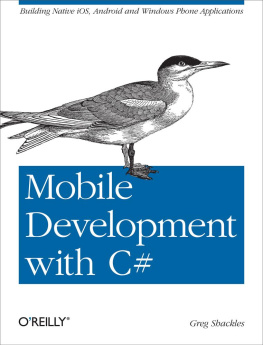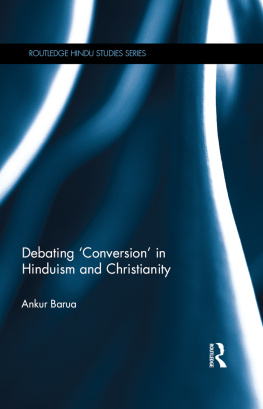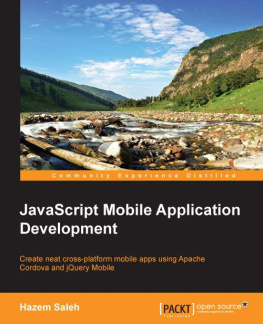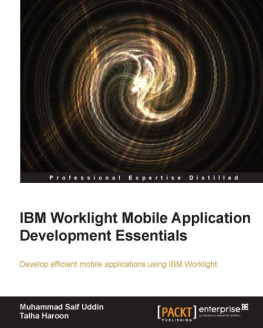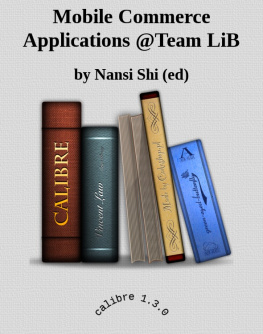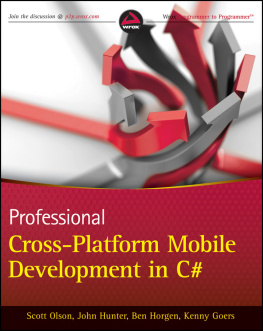Tarkeshwar Barua - Mobile Applications Development
Here you can read online Tarkeshwar Barua - Mobile Applications Development full text of the book (entire story) in english for free. Download pdf and epub, get meaning, cover and reviews about this ebook. year: 2020, publisher: De Gruyter, genre: Computer. Description of the work, (preface) as well as reviews are available. Best literature library LitArk.com created for fans of good reading and offers a wide selection of genres:
Romance novel
Science fiction
Adventure
Detective
Science
History
Home and family
Prose
Art
Politics
Computer
Non-fiction
Religion
Business
Children
Humor
Choose a favorite category and find really read worthwhile books. Enjoy immersion in the world of imagination, feel the emotions of the characters or learn something new for yourself, make an fascinating discovery.

- Book:Mobile Applications Development
- Author:
- Publisher:De Gruyter
- Genre:
- Year:2020
- Rating:5 / 5
- Favourites:Add to favourites
- Your mark:
- 100
- 1
- 2
- 3
- 4
- 5
Mobile Applications Development: summary, description and annotation
We offer to read an annotation, description, summary or preface (depends on what the author of the book "Mobile Applications Development" wrote himself). If you haven't found the necessary information about the book — write in the comments, we will try to find it.
Mobile Applications Development — read online for free the complete book (whole text) full work
Below is the text of the book, divided by pages. System saving the place of the last page read, allows you to conveniently read the book "Mobile Applications Development" online for free, without having to search again every time where you left off. Put a bookmark, and you can go to the page where you finished reading at any time.
Font size:
Interval:
Bookmark:
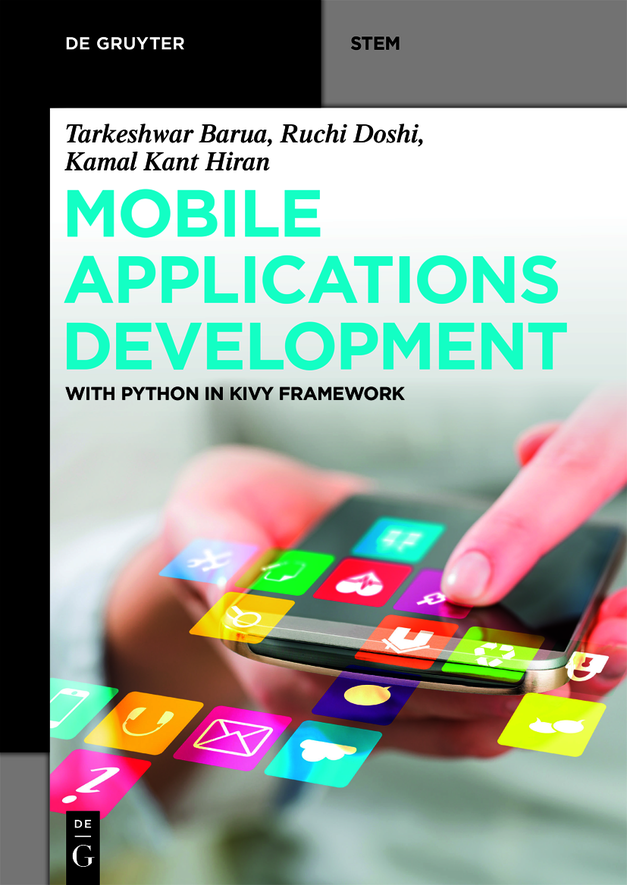
Nowadays, all major IT companies such as Google, Microsoft, and Apple, are using Python as the primary programming language. Python is the most accessible programming language to be learnt quickly in a short period. It can develop any application such as desktop, web application, mobile application, and utility tools, with the help of a wide range of frameworks and libraries available with minimum coding. It is free and open-source available with proper documentation over the Internet. Python focuses on business logic instead of the basic facts of programming. It is available in two versions 2.x and 3.x but primarily, the focus will be on 3.7 and the upcoming Python 3.8.
Python 3.8 will be full of new features with its main emphasis on performance-related issues. Python is dynamically typed, automatically collects garbage, and manages memory with multiple programming paradigms such as procedural, object-oriented programming (OOP), and functional. Python is an agile language that allows the user to do many customized things within a short span of time. The application development can commence from any point of the module and, in the ending phase of application development, can join each other just before releasing.
- Python is very slow in terms of execution of the program in comparison to other programming languages such as C, C++, and Java.
Java is the fastest language because of Java Virtual Machine (JVM) and Just In Time (JIT) compiler. For further information, one can refer to YouTube videos.
- Drawing sophisticated graphics is computationally quite expensive. This reduces graphics quality.
- Without Cython code, execution is very slow. Cython enables us to compile our code at C level.
C compiler optimizes the things.
- GPU or Cython is required for better performance.
- We can limit the speed of the application in order to use vast resources.
After 10 years, the 2.0 version was released in the year 2000 with new features like comprehensions, cycle-detecting garbage collection, and Unicode support. Rossum was a big fan of the group and their quirky humor. Python programs often use the group jokes and famous quotes in their code as a tribute. With various major updates, Python is available in two major versions Python 3.x and 2.x. Python 2.x is a legacy version that would continue up to the year 2020 while python 3.x is a fast updated and popular version. Some features can be imported from python 3 using __future__ in Python 2.x.
Python 3.0 was released in the year 2008, and it was the major release without backward compatibility, which means Python 2.x code could not run over the 3.x series. This major issue was fixed in python 3.7 version for a large amount of code had been written in 2.X series. Initially, this support was offered up to 2015 but now it has been extended up to . Rossum solely took this responsibility up to July 2018, and now he shares his leadership as a member of a five-person steering council. Now, the steering council will release the next upcoming versions.
- Using the English language, python program becomes very easy for coding.
- Python is based on Interpreted language, which saves a lot of time for the execution of the application.
- Procedural programming, OOP, and functional programming support; using thread module Python supports multi-threading.
- Python Android and iOS templates parse to ease generating a dynamic page for the client.
- Interactive language; Python code never converts human-readable code for execution.
- Interactive language; Python code never converts human-readable code for execution.
This feature makes Python very interactive by making changes at run time.
- Python supports Android and iOS by KIVY framework.
- Platform-independent; same code can be executed on all available platforms.
We can achieve it with the help of forward-slash (/) and star (*), where (/) indicates that some function parameters must be specified prepositionally and cannot be used as a keyword argument. We can define positional only parameters for functions. Here, developers can force some arguments to be positional only. Observe the given example: >>def myfunction (a,b,/,c,d,e,*,f,g,h): >> print(a,b,c,d,e,f,g,h) >>myfunction(1,2,3,4,5,6,7,8) Traceback (most recent call last):F File "", line 1, in TypeError: myfunction() takes 6 positional arguments but 8 were given in the given example is applicable after python 3.8 and above Python initialization and configuration Python 3.8 adds a new C API to configure the Python initialization providing better control on the whole configuration and better error reporting. Python code configuration is scattered all around the code. Vectorcall is the fastest calling protocol for Cpython. Vectorcall is the fastest calling protocol for Cpython.
It is the default implementation of Python, and it compiles the source code into intermediate byte code, which is executed by the Cpython virtual machine. It allows for far faster internal Python methods without the overhead of creating temporary objects to handle the call. Any extension-type implementation is callable, and we can use this protocol. Run time audit hooks provide two APIs in the Python run time for hooking events and making them observable to outside tools like testing frameworks or logging and auditing systems. An audit hook is an exit point that allows the auditor to add the modules subsequently. This happens by activating the hook to transfer control to an audit module.
The verified open hook allows Python administrators and embedders to integrate with the operating system support while launching scripts or importing python code. An audit hook and a verified open hook allow applications and frameworks written in pure Python code to take advantage of extra notifications.
Font size:
Interval:
Bookmark:
Similar books «Mobile Applications Development»
Look at similar books to Mobile Applications Development. We have selected literature similar in name and meaning in the hope of providing readers with more options to find new, interesting, not yet read works.
Discussion, reviews of the book Mobile Applications Development and just readers' own opinions. Leave your comments, write what you think about the work, its meaning or the main characters. Specify what exactly you liked and what you didn't like, and why you think so.


